Vitiligo: Understanding Treatment Options for Restoring Skin Tone
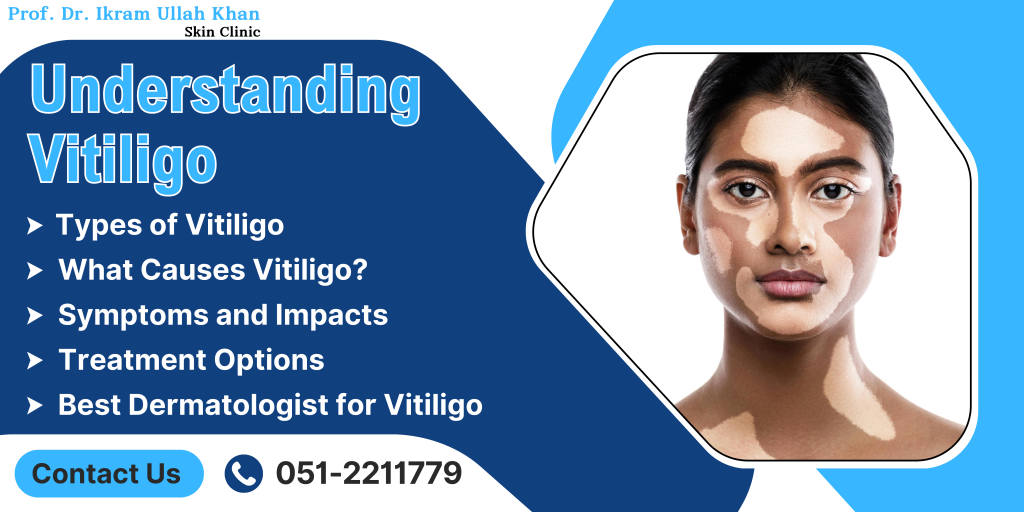
Vitiligo is an autoimmune condition that presents itself as white patchy depigmentation of the skin and affects millions of individuals. Though vitiligo does not affect the physical health of an individual, it does have severe psychological effects. To patients who need to find the right treatment for vitiligo, the changes are unmeasurable and positive.
The patients can avail advanced treatment of vitiligo at the clinic of Prof. Dr. Ikram Ullah Khan one of the best dermatologist in Islamabad. Essentially, this guide will focus on factors leading to vitiligo, available treatments. Also, we’ll see why it is important to consult an experienced dermatologist.
What Is Vitiligo?
Vitiligo is a skin disorder that results when melanocytes, cells that produces melanin the skin colour pigment destroy. When these cells destroyed they turn the skin pale or white. This skin disease can occur anywhere on the human body; on the face, hands, feet, and the scalp in particular as it can cause white hair.
Types of Vitiligo
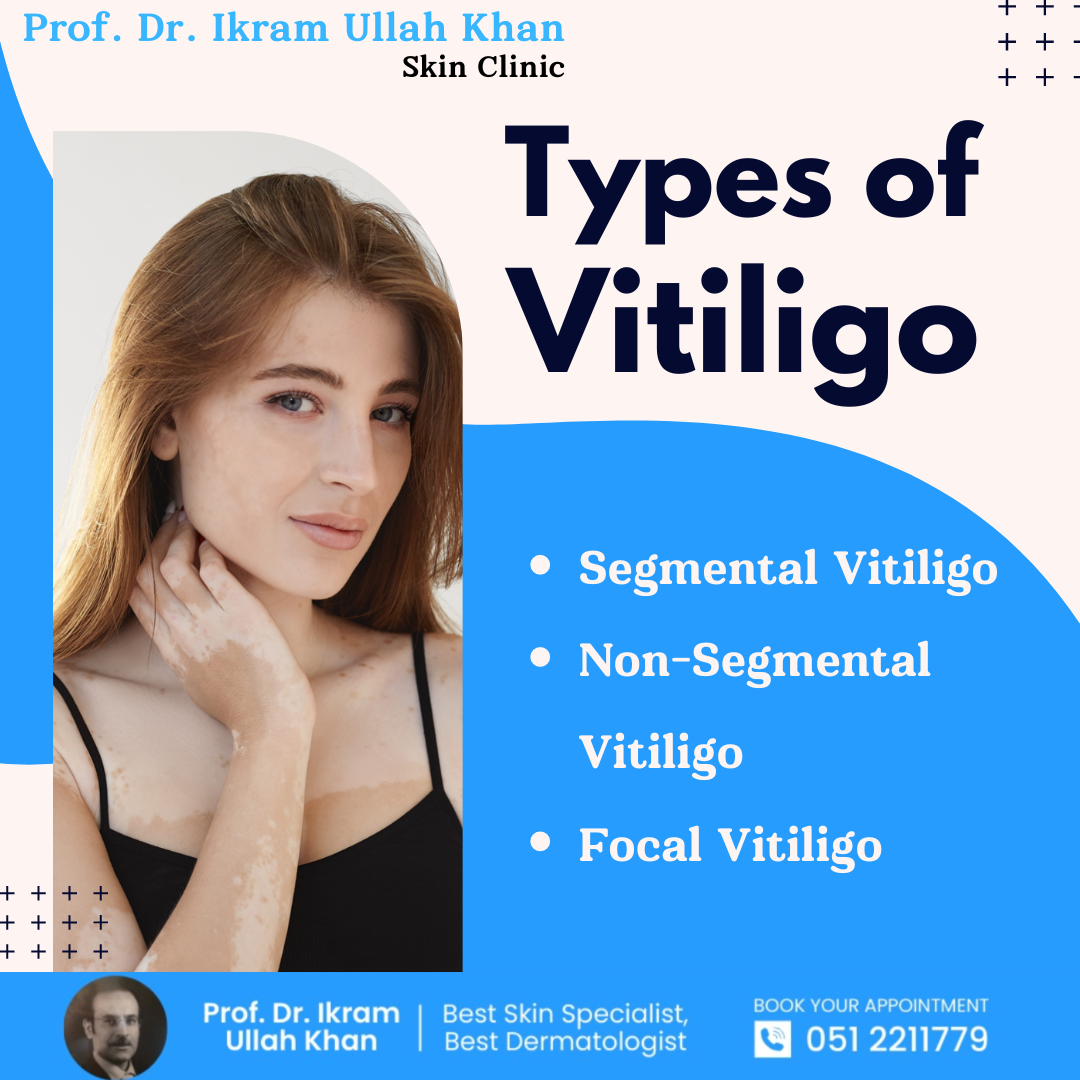
Segmental Vitiligo:
Involve only one side or half of the body. It is more regional and typical of presenting at a younger age.
Non-Segmental Vitiligo:
This is the most frequent type and permits symmetrical depigmentation areas on the two sides of of the body.
Focal Vitiligo:
Has an impact on a localized area of the body and is not contagious.
What Causes Vitiligo?
Vitiligo has its origin in auto immune disease although the exact reason is still unknown. It is an auto immune condition in which the body’s own immune system destroys melanocytes leading to a loss of color in the skin. Other cause includes genetics as vitiligo can be hereditary.
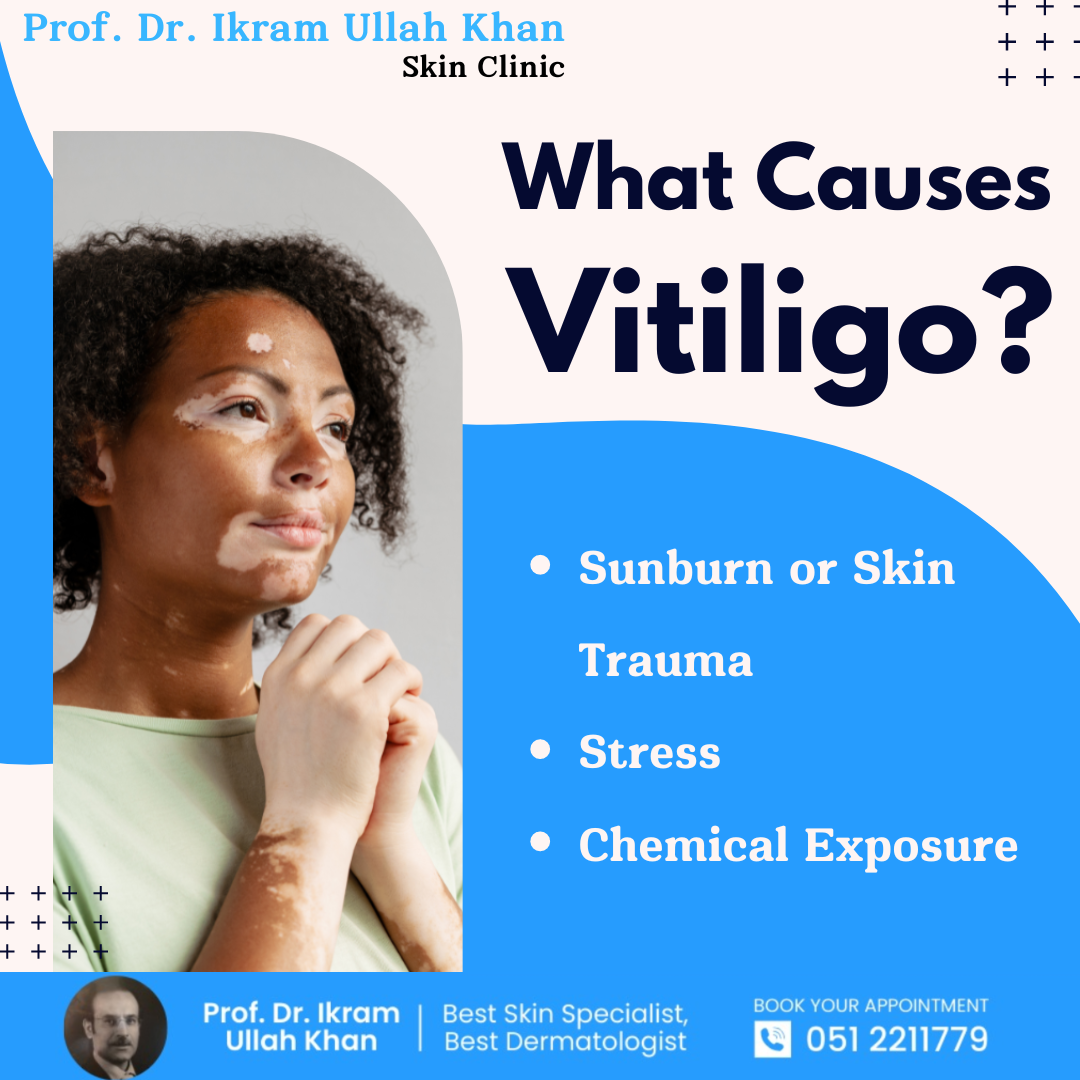
In addition to autoimmune causes, other factors that may contribute to vitiligo include:
- Sunburn or Skin Trauma: Severe sunburn or physical trauma to the skin may trigger the onset of vitiligo in predisposed individuals.
- Stress: Psychological or emotional stress has direct link to the onset and worsening of vitiligo in some cases.
- Chemical Exposure: Certain chemicals can trigger the development of vitiligo by damaging the skin and melanocytes.
Symptoms and Impact of Vitiligo
The primary symptom is the appearance of white or depigmented patches on the skin. These patches may vary in size and shape, and they can gradually increase over time. While vitiligo itself does not cause physical discomfort, it can have a profound impact on a person’s self-esteem and emotional well-being due to its visible nature.
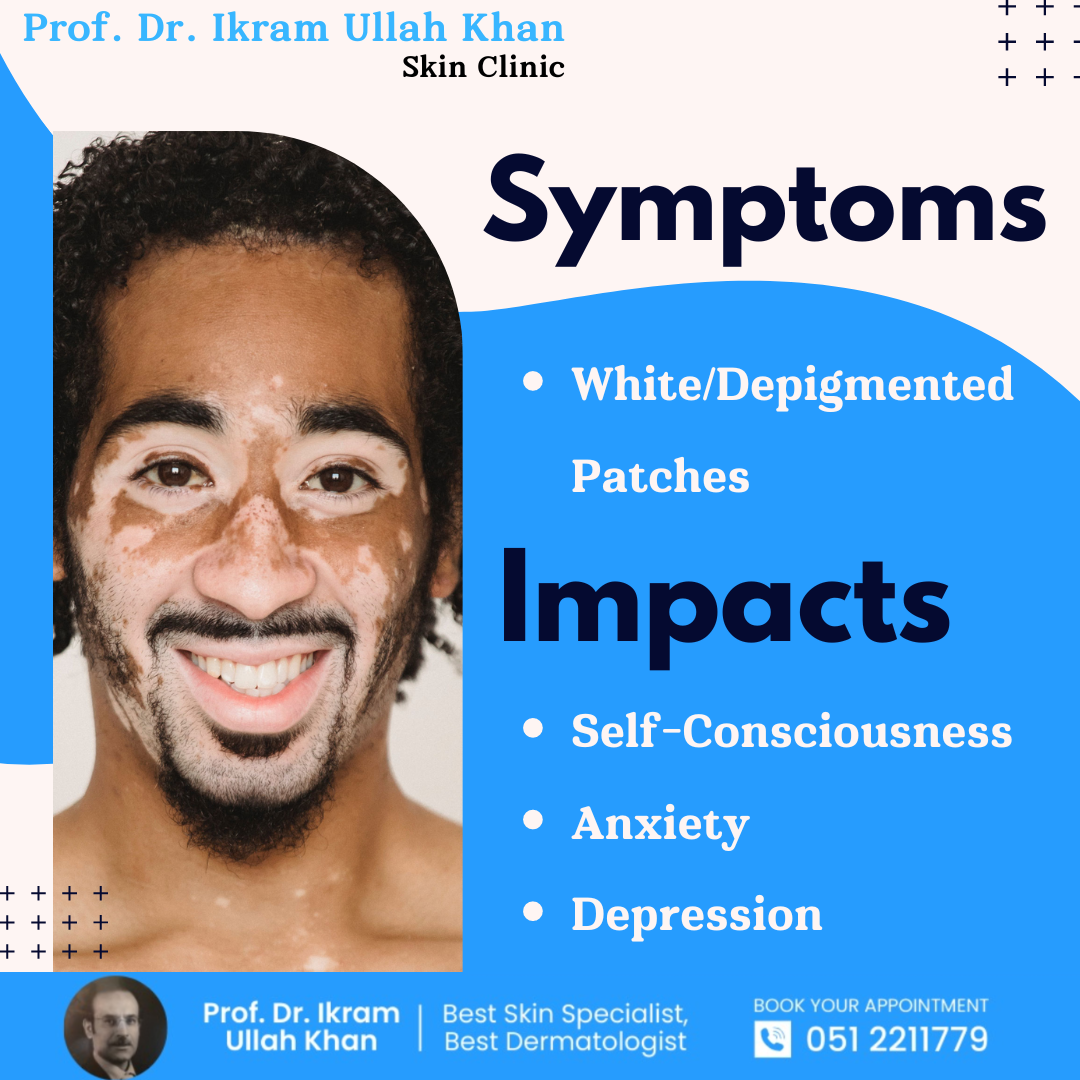
For many individuals, vitiligo can lead to feelings of self-consciousness, anxiety, or even depression, particularly when the patches appear on the face or other highly visible areas of the body. Therefore, finding effective treatment is not just about restoring skin pigmentation; it’s about restoring confidence and emotional health.
Treatment Options for Vitiligo
While its complete cure is not possible, there are several effective treatments available that can help restore skin color and reduce the appearance of white patches. At Prof. Dr. Ikram Ullah Khan’s clinic, recognized as one of the top skin specialists in Islamabad, patients have access to cutting-edge therapies tailored to their specific needs.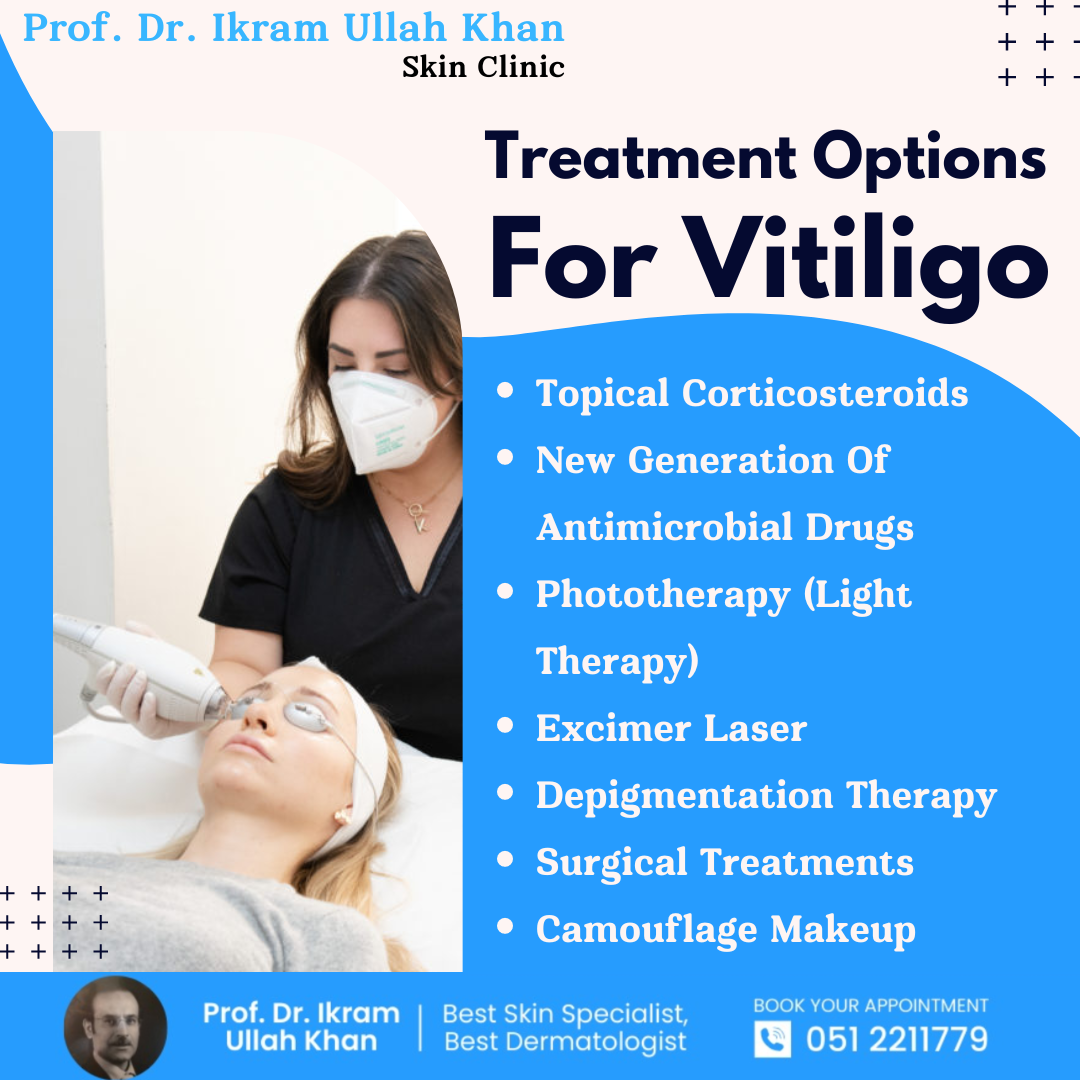
Here are some of the most effective treatments for vitiligo:
1. Topical Corticosteroids
Systemic corticosteroids, however, should not be used to treat vitiligo as a topical corticosteroids are usually used in managing vitiligo. These medications help in reducing immune response on the melanocytes meaning that pigment restores back to the area in question. Topical steroids work best in the initial stage of the illness and may also be useful to halt the progression of vitiligo.
Prof. Dr. Ikram Ullah Khan prescribes corticosteroids according to the intensity and areas of depigmentation.
2. New Generation of Antimicrobial Drugs
Other vitiligo treatment is calcineurin inhibitors types which include tacrolimus and pimecrolimus. These medications help to down regulate the immune system so that it will stop attacking melanocytes. They usually serve as a substitute to corticosteroids, especially when corticosteroids are not good enough for long-term use.
Topical treatments of this type are most suitable for patients with localized vitiligo or with a mild to moderate degree of depigmentation and can be combined with other forms of therapy.
3. Phototherapy (Light Therapy)
Narrowband ultraviolet B (NB-UVB) phototherapy is one of the most effective to treat vitiligo. This is a procedure that entails reintroduction of the skin to a particular intensity of UV radiation in order to trigger functioning of Melanocytes and thus promote skin colorality.
Some of the patients of Prof. Dr. Ikram Ullah Khan,the reputed dermatologist in Islamabad, might have daily NB-UVB therapeutic sessions which is supplemented with topical applications in the process of treatment. Phototherapy is most useful for Diffuse vitiligo and can be used in patients with segmental and non-segmental vitiligo.
4. Excimer Laser
The excimer laser is more a precisely directed form of light therapy and used in application for affected small skin areas of vitiligo. The machine has the ability to emit an ultraviolet light wavelength of 308nm that selectively heals the areas with accumulated keratinocytes and signals skin pigmentation back into the damaged region without harming the healthy skin. This makes it ideal for treating localized vitiligo patches, such as those on the face or hands.
Prof. Dr. Ikram Ullah Khan is a leading skin specialist who offers excimer laser therapy as part of his comprehensive vitiligo treatment options.
5. Depigmentation Therapy
In patients with generalized vitiligo, who have more than 50% of skin depigmentation, depigmentation therapy can be performed. This is the process of using a cream on the active pigmented skin parts to make it blend with the depigmented skin sections. The objective then is to nullify the remaining pigment in order to return the complexion to one of even coloring.
Depigmentation therapy is said to be a permanent cure thus only given to patients willing and prepared to be depigmented all over.
6. Surgical Treatments
Sometimes surgery may be employed to give back the ability to tan in sites that have not responded to other therapies. Surgical options include:
- Skin Grafting: This involves moving of pigmented normal skin from a site to another to replace the depigmented site in the body. They work best only on small, stable lesional vitiligo skin areas.
- Cellular Suspension Transplantation: In this procedure, melanocytes are extracted from a small piece of the patients skin. They are then cultured in the laboratory. Then grafted onto the depigmented areas to replenish color to the skin defeated area.
These surgical interventions are complex and is useful for individuals with nonprogressive vitiligo, when other approaches have been ineffective.
7. Camouflage Makeup
Although it is not a treatment for vitiligo, people with this disease use concealers to hide depigmented skin and obtain a more uniform color. Camouflage makeup products are created to be completely sophisticated and resilient, resistant to water and available in various color profiles.
Why Choose Prof. Dr. Ikram Ullah Khan?
Vitiligo is a skin disorder of some complexity and it is only controllable by an expert. It usually need an individual approach. Prof. Dr. Ikram Ullah Khan, identified as one of the bets skin specialist in Islamabad, offers different treatment procedures for the patients depending on the specific need. Here’s why you should trust Prof. Dr. Ikram Ullah Khan with your vitiligo care:
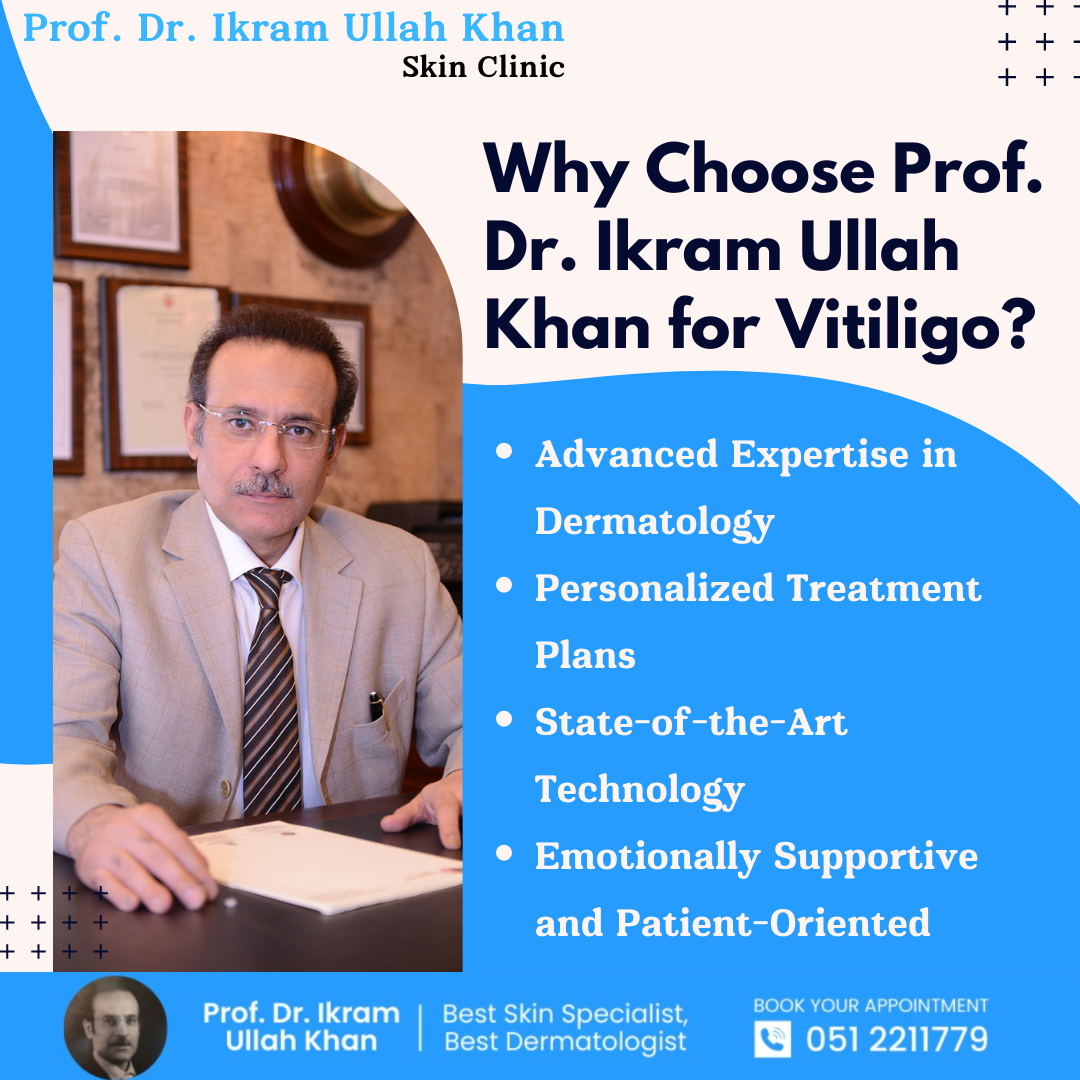
1. Advanced Expertise in Dermatology
Prof. Dr. Ikram Ullah Khan specializes in treating skin problems which makes him the top skin specialist in Islamabad. He keeps abreast with technological improvement in the skin medical practice to afford our patients the best services.
2. Personalized Treatment Plans
The vitiligo cannot be same in all the people. This is why Prof. Dr. Ikram Ullah Khan suggest the treatment plan according to the pattern and behavior of vitiligo in a patient. He always assesses every patient’s state of health, skin type and medical history. After that he suggests best treatment plan to adopt in order to get the best results.
3. State-of-the-Art Technology
Prof. Dr. Ikram Ullah Khan is a board-certified dermatologist and skin specialist who offers the most innovative solutions. These solutions include excimer lasers, phototherapy, and new topical solutions. He has all the modern equipment suited for his clinic to guarantee his patients the best results.
4. Emotional Supportive and Patient-Oriented Care
People have to face emotional problems, and Prof. Dr. Ikram Ullah Khan knows how to treat people gently. This clinic really cares about the patient and his feelings. We aim to give the patient full confidence during the entire process of therapy.
Conclusion: Get Your Skin Back to Health Through Professional Treatment
Although it is a complicated skin disease, it is certainly not the end of the world for affected person. With the help of a proper treatment plan done by one of the top dermatologists near me, Prof. Dr. Ikram Ullah Khan, you can deal with vitiligo and regain your self-esteem.
If you are listing your vitiligo as small and isolated or large and spread out, there’s a solution for you. Consult with the best dermatologist in Islamabad, Prof. Dr. Ikram Ullah Khan today! And get a chance of getting back your skin and confidence. To learn more do not forget to visit our YouTube Channel.
